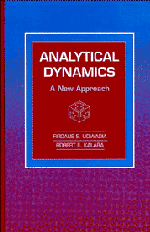Book contents
7 - GAUSS'S PRINCIPLE REVISITED
Published online by Cambridge University Press: 22 March 2010
Summary
The reader will recall that we began our study of constrained motion in Chapter 3 by invoking Gauss's principle. There, we simply stated the principle as a basic principle of mechanics. We obtained the fundamental equation which described the motion of systems constrained by holonomic and nonholonomic constraints using this principle. It behooves us to understand Gauss's principle in greater depth now, moving full circle, as it were, by coming around to where we started from. This will be our agenda for this chapter.
We will begin with a simple proof of Gauss's principle in Cartesian coordinates, based on equation (5.18), the basic equation of analytical mechanics which we introduced in Chapter 5. We will next interpret this equation physically to demonstrate its aesthetic beauty, and then move on to prove the principle in terms of generalized coordinates. Using this principle, we will then provide an alternative proof for the fundamental equation in generalized coordinates.
Statement of Gauss's Principle in Cartesian Coordinates
Consider a system of n particles. The inertial Cartesian coordinates of the n particles can be described by the 3n-vector x = [x1x2x3 … x3n−1x3n]T in which the first three elements of the vector x correspond to the X-, Y- and Z- components of the position of the first particle, the next three elements correspond to the X-, Y- and Z-components of the position of the second particle, etc.
- Type
- Chapter
- Information
- Analytical DynamicsA New Approach, pp. 220 - 235Publisher: Cambridge University PressPrint publication year: 1996

